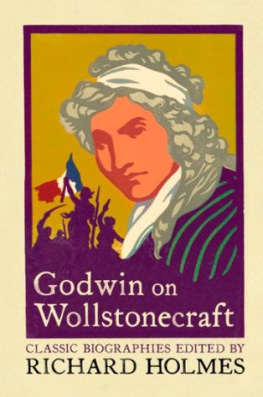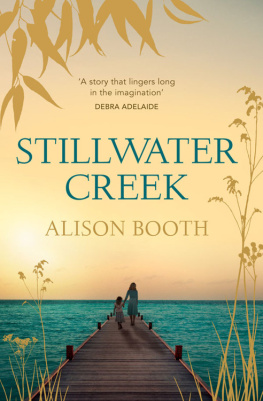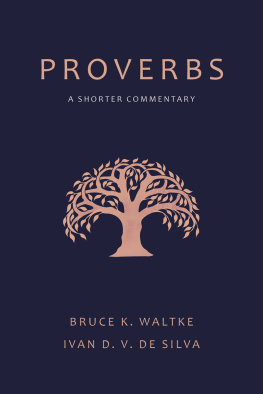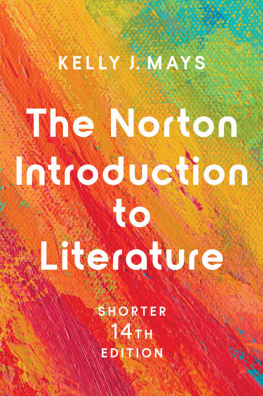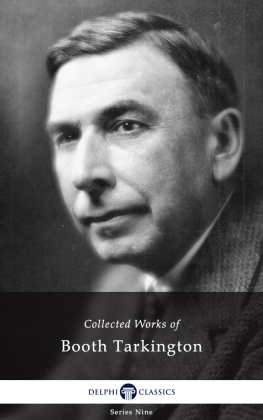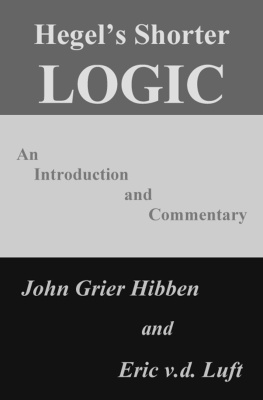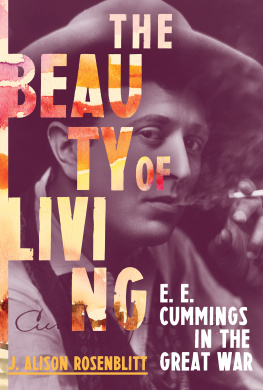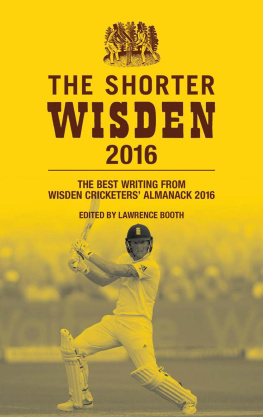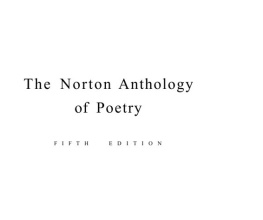Alison Booth - The Norton Introduction to Literature- Shorter Version- Text Only
Here you can read online Alison Booth - The Norton Introduction to Literature- Shorter Version- Text Only full text of the book (entire story) in english for free. Download pdf and epub, get meaning, cover and reviews about this ebook. year: 2006, publisher: W W Norton & Co Inc, genre: Non-fiction. Description of the work, (preface) as well as reviews are available. Best literature library LitArk.com created for fans of good reading and offers a wide selection of genres:
Romance novel
Science fiction
Adventure
Detective
Science
History
Home and family
Prose
Art
Politics
Computer
Non-fiction
Religion
Business
Children
Humor
Choose a favorite category and find really read worthwhile books. Enjoy immersion in the world of imagination, feel the emotions of the characters or learn something new for yourself, make an fascinating discovery.
- Book:The Norton Introduction to Literature- Shorter Version- Text Only
- Author:
- Publisher:W W Norton & Co Inc
- Genre:
- Year:2006
- Rating:5 / 5
- Favourites:Add to favourites
- Your mark:
- 100
- 1
- 2
- 3
- 4
- 5
The Norton Introduction to Literature- Shorter Version- Text Only: summary, description and annotation
We offer to read an annotation, description, summary or preface (depends on what the author of the book "The Norton Introduction to Literature- Shorter Version- Text Only" wrote himself). If you haven't found the necessary information about the book — write in the comments, we will try to find it.
The Norton Introduction to Literature- Shorter Version- Text Only — read online for free the complete book (whole text) full work
Below is the text of the book, divided by pages. System saving the place of the last page read, allows you to conveniently read the book "The Norton Introduction to Literature- Shorter Version- Text Only" online for free, without having to search again every time where you left off. Put a bookmark, and you can go to the page where you finished reading at any time.
Font size:
Interval:
Bookmark:
It is often said that William Godwins Memoirs of the Author of The Rights of Woman of 1798 destroyed Mary Wollstonecrafts reputation for over 100 years. If that is true, it must count as one of the most dramatic, as well as the most damaging, works of biography ever published.
At the time of her death in London on 10 September 1797, Mary Wollstonecraft was certainly well-known and widely admired, as an educational writer and champion of womens rights. She was renowned not only in Britain, but also in France, Germany and Scandinavia (where her books had been translated), and in newly-independent America. Although only 38 years old, she was already one of the literary celebrities of her generation.
The Gentlemans Magazine, a solid large-circulation journal of record with a conservative political outlook, printed the following obituary in October 1797, with an admiring if guarded summary of her career and an unreservedly favourable estimate of her character.
In childbed, Mrs Godwin, wife of Mr. William Godwin of Somers-town; a woman of uncommon talents and considerable knowledge, and well-known throughout Europe by her literary works, under her original name of Wollstonecraft, and particularly by her Vindication of the Rights of Woman, 1792, octavo.
Her first publication was Thoughts on the Education of Daughters, 1787her second, The Rights of Man, 1791, against Mr Burke on the French Revolution, of the rise and progress of which she gave an Historical and Moral View, in 1794her third, Elements of Morality for the Use of Children, Translated from the German, 1791her fourth, A Vindication of the Rights of Woman, 1792her fifth, Letters Written during a Short Residence in Sweden, Norway and Denmark, 1796.
Her manners were gentle, easy and elegant; her conversation intelligent and amusing, without the least trait of literary pride; or the apparent consciousness of powers above the level of her sex; and for soundness of understanding, and sensibility of heart, she was perhaps, never equaled. Her practical skill in education was even superior to her speculations upon that subject; nor is it possible to express the misfortune sustained, in that respect, by her children. This tribute we readily pay to her character, however adverse we may be to the system she supported in politicks and morals, both by her writing and practice.
Many other favourable articles appeared, such as her friend Mary Hayss combative obituary in the Monthly Magazine for September 1797, which lauded her ardent, ingenuous and unconquerable spirits, and lamenting that she was a victim to the vices and prejudices of mankind. The Monthly Mirror praised her as a champion of her sex, and promised an imminent biography, though this did not appear. Friends in London, Liverpool, Paris, Hamburg, Christiana, and New York expressed their shock at her sudden departure, one of the earliest, premature Romantic deaths of her generation. It seemed doubly ironic that the champion of womens rights should have died in childbirth.
William Godwin, her husband, was devastated. They had been lovers for little over a year, and married for only six months. At 42 he also was a literary celebrity, but of a different kind from Mary. A shy, modest and intensely intellectual man, he was known paradoxically as a firebrand philosopher: the dangerous radical author of An Enquiry Concerning Political Justice (1793) and the political thriller-novel Caleb Williams (1794). His views were even more revolutionary than hers. He proposed republican, atheist and anarchist ideas, attacking many established institutions, such as private property, the Church, the monarchy, and (ironically) marriage itself that most odious of monopolies. Indeed he was notorious for his defence of free love, and their marriage in March 1797 had been the cause of much amusement in the press. Yet Godwin believed passionately in the rational power of truth, and the value of absolute frankness and sincerity in human dealings.
He was in a state of profound shock. He wrote bleakly to his oldest friend and confidante, the playwright Thomas Holcroft on 10th September 1797, the very evening of her death: My wife is now dead. She died this morning at eight oclockI firmly believe that there does not exist her equal in the world. I know from experience we were formed to make each other happy. I have not the least expectation that I can now ever know happiness again. When you come to town, look at me, talk to me, but do not if you can help it exhort me, or console me.
Another of Godwins friends, Elizabeth Fenwick wrote two days later to Marys younger sister, Evarina Wollstonecraft, in Dublin. I was with [Mary] at the time of her delivery, and with very little intermission until the moment of her death. Every skillful effort that medical knowledge of the highest class could make, was exerted to save her. It is not possible to describe the unremitting and devoted attentions of her husbandNo woman was ever more happy in marriage than Mrs Godwin. Whoever endured more anguish than Mr Godwin endures? Her description of him, in the very last moments of her recollection was, He is the kindest, best man in the world.
Mrs Fenwick added thoughtfully, and perhaps tactfully: I know of no consolation for myself, but in remembering how happy she had lately been, and how much she was admired, and almost idolized, by some of the most eminent and best of human beings.
To take advantage of this surge of interest and sympathy across the literary world, Wollstonecrafts life-long friend and publisher, Joseph Johnson, proposed to Godwin an immediate edition of her most recent writings. This was to include most notably her long, but unfinished, novel Maria, or The Wrongs of Woman, which had a strong autobiographical subtext. It was a shrewd idea, to provide a fictional follow-up to Marys most famous work of five years previously, The Rights of Woman. The two titles cleverly called attention to each other: The Rights reinforced by The Wrongs.
Though unfinished, The Wrongs of Woman: A Fragment in Two Volumes contained a celebration of true Romantic friendships, and a blistering attack on conventional marriage. The narrator Marias husband has committed her to a lunatic asylum, having first brought her to court on a (false) charge of adultery. The judges summary of Marias case, which comes where the manuscript breaks off, ironically encapsulates many of the male prejudices that Mary Wollstonecraft had fought against all her life.
The judge, in summing up the evidence, alluded to the fallacy of letting women plead their feelings, as an excuse for the violation of the marriage-vow. For his part, he had always determined to oppose all innovation, and the new-fangled notions that encroached on the good old rules of conduct. We did not want French principles in public or private life and, if women were allowed to plead their feelings, as an excuse or palliation of infidelity, it was opening a flood-gate for immorality. What virtuous women thought of her feelings? it was her duty to love and obey the man chosen by her parents and relations
Johnson also suggested that Godwin should include some biographical materials. The idea for a short memorial essay by Marys husband was mooted, as was the convention in such circumstances; and possibly a small selection from her letters.
Battling against his grief, Godwin determined do justice to his wife by editing her Posthumous Works. Immediately after the funeral on 15 September, he moved into Marys own study at No.9 Polygon, surrounded himself with all her books and papers, and hung her portrait by John Opie above his desk for inspiration. He hired a housekeeper, Louisa Jones, to look after the two children who were now his responsibility: the little motherless baby Mary (the future Mary Shelley); and four-year old Fanny, who was Wollstonecrafts earlier love-child by an American, Gilbert Imlay.
Font size:
Interval:
Bookmark:
Similar books «The Norton Introduction to Literature- Shorter Version- Text Only»
Look at similar books to The Norton Introduction to Literature- Shorter Version- Text Only. We have selected literature similar in name and meaning in the hope of providing readers with more options to find new, interesting, not yet read works.
Discussion, reviews of the book The Norton Introduction to Literature- Shorter Version- Text Only and just readers' own opinions. Leave your comments, write what you think about the work, its meaning or the main characters. Specify what exactly you liked and what you didn't like, and why you think so.

